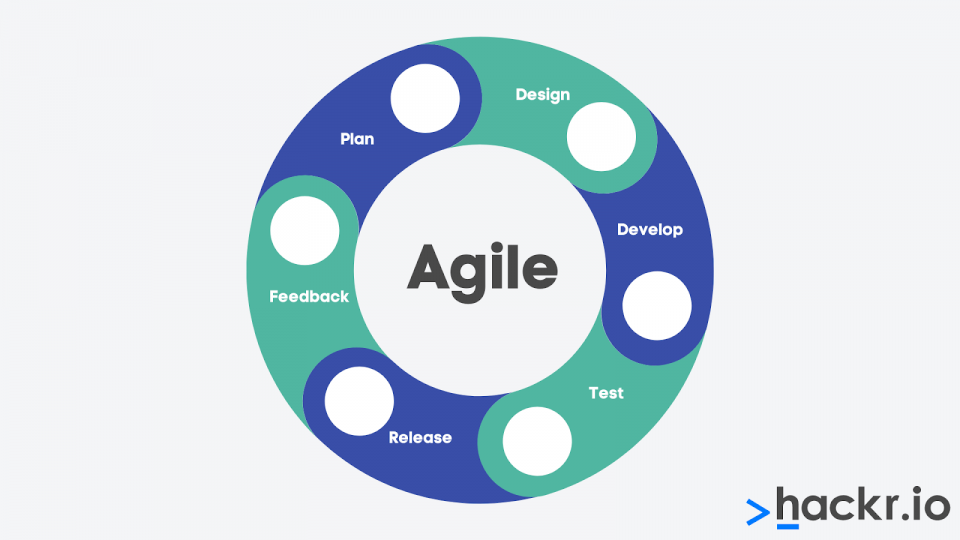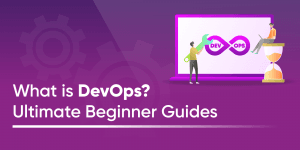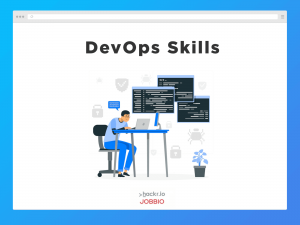DevOps, which stands for Development and Operations, has revolutionized the way software products are developed and distributed. The DevOps methodology focuses on providing frequent smaller upgrades rather than rare big feature sets.
IT operations benefit from DevOps. Before the advent of DevOps, several concerns remained intrinsic to the IT team. That changed with the entry of DevOps, which allows the IT operations to share these concerns with the rest of the organization resulting in enhanced transparency and better coordination.
Here, we list the top interview questions and answers for a DevOps-based role. We've divided the questions into basic DevOps interview questions and advanced DevOps interview questions.
Top DevOps Interview Questions and Answers
1. What is DevOps?
DevOps is a software development practice where development and IT operations are combined from the initial point of designing a product to deployment in the markets.
2. What is the basic premise of DevOps?
DevOps is a cultural shift wherein collaboration and operation teams work together throughout the product or service life cycle. The idea is to help get products out faster and allow for easier maintenance.
3. Which methodology is DevOps related to?
DevOps is related to Agile methodology.
4. What are the main priorities of DevOps?
The priorities in DevOps include resource management, teamwork, and communication.
5. What are the benefits of DevOps?
The varied benefits of DevOps include innovation, stability, functionality, and speed.
6. What are the different phases in DevOps?
DevOps is usually classified into 6 phases. However, phases are not separated by hard boundaries, and no phase begins even if the previous one has ended completely.

1. Planning
Planning and software development is the first phase of the DevOps lifecycle. This phase involves understanding the project properly for the ultimate work goal of its participants.
2. Development
In this phase, the project gets built by designing infrastructure, writing codes, defining tests, or by automation process.
3. Continuous Integration
This phase automates the mechanism of validation and testing. This has a unique feature that ensures the development environment is properly and then published in a service that integrates it with the remaining applications.
4. Automated Deployment
DevOps stimulates the automation of deployments by tools and scripts with the ultimate goal of solving the whole process with the activation of a feature.
5. Operations
Usually, all operations related to DevOps happen continuously throughout the life of software, as there is a dynamic change in the infrastructure. This phase provides opportunities for transformation, availability, and scalability.
6. Monitoring
This phase is a permanent phase of the DevOps process. DevOps monitors and analyzes information that displays the current status of the application.
7. Why has DevOps gained popularity over the past few years?
DevOps is in great demand in the current industry and many businesses are eagerly investing in DevOps talent. Major companies such as Facebook and Netflix are investing their money and time in DevOps for automation and speeding up application deployment.
DevOps implementation has given provable results in businesses that contend higher efficiency, with its new technology standards; tech workers can implement codes faster than ever before, and with fewer errors.
8. What are Ansible and Puppet?
Puppet and Ansible are the tools that are used for managing a large number of servers. These are also called Remote Execution and Configuration Management tools, and it allows the admin to perform or execute the commands on many servers simultaneously. Its main feature is generally to maintain and configure thousands of servers at a single time.
9. What are the benefits of using the Version Control System (VCS)?
The key benefits of Version Control are as follows:
- With the Version Control System (VCS), all the workers are allowed to access the file freely at any time. It also allows merging all the changes that are made in a common version.
- It is designed to help multiple people collaboratively edit text files, which makes sharing comparatively easy between multiple computers.
- It is important for documents that require a lot of redrafting and revision as they provide an audit trail for redrafting and updating final versions.
- It permits all the team members to have access to the complete history of the project so that in case of any breakdown in the central server, we can use any teammate's storehouse.
- All the previous versions and variants are smartly packed up inside the VCS. Any version is requested at any time to get information about the previous complete projects.
10. What are the different components of Selenium?
Selenium is an open-source tool that is used for automating different web applications. It has mainly four major components that help to run multiple test cases and provides services for using various browsers and languages for automation. The components of Selenium are as follows:
1. Selenium IDE
Selenium IDE (Integrated Development Environment) is one of the simplest frameworks in the selenium suite. It has an easy record and playback function, which helps in figuring out the tool that provides easy learning.
2. Selenium RC
Selenium RC (Remote Control) is a tool that helps in understanding test scripts and providing support for different programming languages like Ruby, PHP, Java, etc.
3. Selenium WebDriver
This is mainly an extension of selenium RC, but it supports all the latest browsers and many platforms. It is created to support vital web pages in which elements present on the page can change without reloading the page, and it directly calls the browser for automation.
4. Selenium GRID
Selenium GRID is a tool that runs multiple test cases against different browsers and machines in parallel. Several nodes are not fixed in the grid, and it can be launched on various browsers and platforms. It is used together with Selenium RC.
11. What is the purpose of configuration management in DevOps?
Configuration management helps automate tasks that are otherwise time-consuming and tedious and enhances an organization's agility. It brings consistency and improves the process of a product/service by streamlining design, documentation, control, and implementation of changes during various phases of the project.
12. What is the purpose of AWS in DevOps?
Amazon Web Services (AWS) services support the automation of manual tasks and processes that help developers build applications faster and more efficiently. These processes can be deployment, development, test workflows, configuration management, and container management.
13. What is the difference between a centralized and distributed version control system (VCS)?
In a centralized repository system, the repository is located in a central location, and clients access this system when they need something. In such a version control system, the repository is always updated with the latest changes as the changes are directly committed to the central system; therefore, all the clients always have access to the latest code. CVS and SVN are examples of centralized VCS.
In a distributed VCS, everyone in the team has their repository, which is a mirror of the central repository. It provides flexibility, as one can work offline. Only when the changes have to be committed to the central system, do you need to be online. This makes distributed VCS faster. Git and Mercurial are distributed VCS.
14. What are the differences between git pull and git fetch?
|
git fetch |
git pull |
|
The command is: git fetch <remote> |
The command is: git pull <remote> <branch> |
|
Fetches the changes from the remote repository but doesn't merge them with the local repository. |
Fetches the changes of the branch from the remote repository and merges them with the local repository. Pull is fetch plus merge. |
|
Done at the latter stages, since no merging is involved, there are no conflicts to be resolved. |
There are chances of merge conflicts if two or more people are working on different copies of the same code/file. |
|
The local repository is unchanged, but the central repository is updated. |
The changes from the central repository are updated in the local repository. |
|
Developers can see the changes made by others before they push their changes for integration. |
Developers can first bring the latest files to their local, and then start updating the same. |
15. What is git stash?
Git stash command is used to save the changes temporarily in the working directory. This gives developers a clean directory to work on. They can later merge the changes in the git workflow. If this command is used, the changes in the tracked files are merged in the working directory. Git stash command can be used many times in the git directory.
16. What is a merge conflict in Git, and how can it be resolved?
Merge conflicts occur when changes are made to a single file by multiple people at the same time.
Due to this, Git won't be able to tell which of the multiple versions is the correct version.
To resolve the conflicts, we should create a new Git repo, add a file, create a branch, make the edits and commit the changes.
The next step is to merge the new branch into the master. Once this is done, Git clearly shows the differences in the different versions of the file and where the edits need to be made to remove the conflicts.
17. What are the fundamental differences between DevOps and Agile?
Although DevOps shares some similarities with the Agile methodology, which is one of the most popular SDLC methodologies, both are fundamentally different approaches to software development.

The following are the various fundamental differences between the two:
- Agile Approach: The agile approach is only meant for development in Agile while the agile approach is meant for both development and operations in DevOps.
- Practices and Processes: While agile involves practices such as Agile Scrum and Agile Kanban, DevOps involves processes such as CD (Continuous Delivery), CI (Continuous Integration), and CT (Continuous Testing).
- Priority: Agile prioritizes timeliness whereas DevOps gives equal priority to timeliness and quality.
- Release Cycles: DevOps offers smaller release cycles with immediate feedback while Agile offers only smaller release cycles without immediate feedback.
- Feedback Source: Agile relies on feedback from customers while feedback from self (monitoring tools) is involved in DevOps.
- Scope of Work: For Agile, the scope of work is agility only but for DevOps, it is agility and the need for automation.
18. Why do we need DevOps?
Organizations these days are trying to transport small features to customers via a series of release trains instead of releasing big feature sets. There are several benefits of doing so, including better software quality and quick customer feedback.
With the adoption of DevOps methodology, organizations are able to accomplish tens to thousands of deployments in a single day. Moreover, doing so while offering first-rate reliability, security, and stability.
DevOps helps in fulfilling all these requirements and thus, achieving seamless software delivery. Full-fledged organizations like Amazon, Etsy, and Google have adopted DevOps methodology resulting in achieving performance levels that were previously uncharted.
19. What are the important business and technical benefits of using DevOps?
DevOps brings a lot of business and technical benefits to the table. Some of the most important ones are listed down as follows:
Business benefits:
- Enhanced operating environment stability.
- Faster delivery of features.
- More time for adding value to the product.
Technical benefits:
- Continuous software delivery.
- Faster problem resolution.
- Fewer complex problems.
20. Name some of the most commonly used DevOps tools.
The following is a list of some of the most widely used DevOps tools:
- Ansible: A configuration management and application deployment tool
- Chef: A configuration management and application deployment tool
- Docker: A containerization tool
- Git: A version control system (VCS) tool
- Jenkins: A continuous integration (CI) tool
- Jira: An agile team collaboration tool
- Nagios: A continuous monitoring tool
- Puppet: A configuration management and application deployment tool
- Selenium: A continuous testing (CT) tool
21. What is Selenium used for?
Selenium is used for continuous testing in DevOps. The tool specializes in functional and regression testing.
22. What do you understand about anti-patterns?
When a DevOps pattern commonly adopted by other organizations doesn’t work in a specific context and still the organization continues using it, it leads to the adoption of an anti-pattern. Some of the notable anti-patterns are:
- An organization needs to have a separate DevOps group
- Agile equals DevOps
- DevOps is a process
- DevOps is development-driven release management
- DevOps is not possible because the organization is unique
- DevOps is not possible because the people available are unsuitable
- DevOps means Developers Managing Production
- DevOps will solve all problems
- Failing to include all aspects of the organization in an ongoing DevOps transition
- Not defining KPIs at the start of a DevOps transition
- Reduce the silo-based isolation of development and operations with a new DevOps team that silos itself from other parts of the organization
23. What does CAMS stand for?
The acronym CAMS is usually used for describing the core creeds of DevOps methodology. It stands for:
- Culture
- Automation
- Measurement
- Sharing
24. What are the KPIs used to gauge DevOps success?
In order to measure the success of a DevOps process, several KPIs can be used. Some of the most popular ones are:
- Application performance
- Application usage and traffic
- The automated test pass percentage
- Availability
- Change volume
- Customer tickets
- Defect escape rate
- Deployment frequency
- Deployment time
- Error rates
- Failed deployments
- Lead time
- Mean time to detection (MTTD)
- Meantime to recovery (MTTR)
25. What do you understand about containers?
Containers are a form of lightweight virtualization that help in providing isolation among processes. Containers are heavier than a chroot but lighter than a hypervisor.
26. Microservices are a core part of DevOps. Can you name any two popular Java development frameworks for creating microservices?
There are several Java frameworks that allow the creation of microservices. However, Eclipse MicroProfile and Spring Boot stand out from the herd as the two leading Java development frameworks used in DevOps for creating microservices.
27. What are post-mortem meetings?
Occasionally, there is a need to discuss what went wrong during a DevOps process. For this, post-mortem meetings are arranged. These meetings yield steps that should be taken to avoid the same failure or set of failures in the future for which the meeting was arranged in the first place.
28. Draw a comparison between Asset Management and Configuration Management.
The process of monitoring as well as maintaining things of value to an entity or group is called Asset Management.
Configuration Management refers to the process of controlling, identifying, planning for, and verifying the configuration items within service in support of Change Management.
29. Can we make a new copy of an existing Jenkins job?
Yes, we can make a new copy of an existing Jenkins job by creating a clone of the directory in a different name.
30. What is Ansible?
Ansible work is an open-source automation tool used in DevOps.
31. What are the categories of Ansible in DevOps?
There are two categories of Ansible in DevOps:
- Controlling machines.
- Nodes.
32. Can we install Ansible on the controlling machines?
Yes, we can install Ansible on the controlling machine by using the machine nodes that are managed with the help of SSH.
33. Is Ansible an agentless tool? What are its benefits?
Yes, Ansible is an agentless tool because it does not require any kind of mandatory installation on the remote nodes. The benefits of the Ansible tool include the following:
- Task automation
- Configuration management
- Application deployment
34. What is Forking Workflow?

Forking Workflow gives every developer side repositories, thereby supporting open source projects.
35. How is Forking Workflow better than Git Workflow?
Forking Workflow is better than Git Workflow because it helps in integrating the contributions of different developers without needing everyone to push to a single central repository for cleaning project history. Thus the developers are allowed to push their server-side repositories, and the project maintainer will push to the official repository.
36. What is Git rebase?
Git rebase is a command which is designed to integrate the changes from one branch to another brand.
37. How is Git rebase different from Git merge?
Git rebase is different from Git merge because, in the case of Git rebase, the feature branch is transferred to the master branch's ending point. However, in the case of Git merge, the merging adds to a new commit in the history wherein history does not change, but the master branch is changed.
Advanced DevOps Interview Questions
38. What is CI and what is its purpose?
CI stands for Continuous Integration. It is a development practice in which developers integrate code into a shared repository multiple times in a single day. This enhances the quality of the software as well as reduces the total time required for delivery.
Typically, a CI process includes a suite of unit, integration, and regression tests that run each time the compilation succeeds. In case any of the tests fail, the CI build is considered unstable (which is common during an Agile sprint when development is ongoing) and not broken.
39. What is a shift left in DevOps?
The traditional software development lifecycle when graphed on paper has two sides, left and right. While the left side of the graph includes design and development, the right side includes production staging, stress testing, and user acceptance.
To shift left in DevOps simply means the necessity of taking as many tasks on the right, i.e., that typically happens toward the end of the application development process, and incorporates them into earlier stages of a DevOps methodology.
There are several ways of accomplishing a shift left in DevOps, most notably:
- Create production-ready artifacts at the end of every Agile sprint
- Incorporate static code analysis routines in every build
40. What are the major benefits of implementing DevOps automation?
The following are the major benefits of implementing DevOps automation:
- Reduction in human error.
- As tasks become more predictable and repeatable, it is easy to identify and correct when something goes wrong. Hence, it results in producing more reliable and robust systems.
- Removes bottlenecks from the CI pipeline. This results in increased deployment frequency and decreased number of failed deployments. Both of them are important DevOps KPIs.
41. How do you revert a commit that has already been pushed and made public?
There are two ways of doing so:
- By creating a new commit to undo all changes made by the commit that has already been pushed and made public. The command for doing so is:
git revert - By fixing or removing the bad file in a new commit and then pushing it to the remote repository. After making necessary changes to the file, commit it to the remote repository using the command:
git commit -m “commit message”
42. Can you state and explain the key elements of continuous testing?
The key elements of continuous testing are:
- Advanced analysis: Used for forecasting and predicting unknown future events.
- Policy analysis: Improves the testing process.
- Requirement traceability: Refers to the ability to describe as well as follow the life of a requirement, from its origin to deployment.
- Risk assessment: The method or process of identifying hazards and risk factors that can cause potential damage.
- Service virtualization: Allows using virtual services instead of production services. Emulates software components for simple testing.
- Test optimization: Improve the overall testing process.
43. What are the core operations of DevOps in terms of development and infrastructure>
The core operations of DevOps in terms of development and infrastructure are:
- Application development: Developing a product that is able to meet all customer requirements and offers a remarkable level of quality.
- Code coverage: A measurement of the total number of blocks or lines or arcs of the code executed while the automated tests are running.
- Code developing: Preparing the codebase required for product development.
- Configuration: Allowing the product to be used in an optimum way.
- Deployment: Installing the software to be used by the end-user.
- Orchestration: Arrangement of several automated tasks.
- Packaging: Activities involved when the release is ready for deployment.
- Provisioning: Ensuring that the infrastructure changes arrive just in time with the code that requires it.
- Unit testing: Meant for testing individual units or components.
44. What are the different advantages of Git?
Git has the following advantages:
- It helps in data redundancy and replication.
- It is easily available.
- It supports collaboration.
- It can be used for a variety of projects.
- It uses only one Git directory per repository.
- It supports disk utilization.
- It offers higher network performance.
45. Can we handle merge conflicts in Git?
Yes, we can handle merge conflict through the following three steps:
- Step 1: Developing a clear understanding of the conflict by checking everything using Git status.
- Step 2: Mark and clean up the conflict by applying the merge tool.
- Step 3: Performing commit and merging with the current branch along with the master branch.
46. Can we move or copy Jenkins from one server to another?
Yes, we can move or copy Jenkins from one server to another. For instance, by copying the Jenkins jobs directory can be moved from the older server to the new server.
47. What is the difference between continuous testing and automation testing?
In continuous testing, the process of executing the automated test is part of the software delivery process. In contrast, automation testing is a process wherein the manual process of testing is applied where a separate testing tool helps the developers create test scripts that can be executed repeatedly without any kind of manual intervention.
48. What is the role of a Selenium Grid?
The role of a Selenium Grid is to execute the same or different test scripts on different platforms and browsers. It helps in testing across various environments and saves execution time.
49. Can we secure Jenkins?
Yes, we can secure Jenkins by:
- Ensuring that global security is on.
- Checking if Jenkins is integrated.
- Making sure that the project matrix is enabled.
- Automating the process of setting up rights and privileges.
- Limiting physical access to Jenkins data.
- Applying security audits regularly.
50. What is Jenkins Pipeline?
Jenkins pipeline is a suite of plugins that supports the implementation and integration of Jenkins' continuous delivery pipeline.
51. What is a Puppet Module?
A Puppet Module is a collection of manifests and data, including files, templates, and facts that have a specific directory structure.
52. How is the Puppet Module different from Puppet Manifest?
Puppet Manifests use the .pp extension. They are Puppet programs, which consist of the Puppet Code. On the other hand, Puppet Modules organizes various kinds of Puppet Manifests that can split the Puppet code with it.
Conclusion
That completes the list of the top DevOps interview questions and answers. In addition to increasing your chances of securing a DevOps role, these interview questions for DevOps will also help you assess as well as enhance your current level of DevOps understanding.
Looking for more DevOps interview preparation content? DevOps Interview Questions Preparation Course will take you one step closer to your next DevOps job.
Interviews will not only have questions about DevOps; the interviewer will certainly ask you some generic software development questions as well. Cracking the Coding Interview: 189 Programming Questions and Solutions can help you prepare for generic programming interview questions.
Frequently Asked Questions
1. How do I prepare for a DevOps interview?
You can prepare for your DevOps interview by making sure you’re thoroughly knowledgeable about all the important concepts. The DevOps questions listed above will help you. You can also search for DevOps practical interview questions.
2. What is Docker used for in DevOps?
Docker is used for running isolated environments. You can build portable environments for your tech stack.
3. What is Jenkins used for in DevOps?
Jenkins is an automated software testing server. It is used for Continuous Integration.
People are also reading:

![7 Best AI Coding Assistants In 2023 [Free + Paid]](jpg/16952882603blllo1oza.jpg)
![30 Cool, Easy & Fun Python Projects + Source Code [2023]](png/1655865129yuz5v1mdab.png)

![The 14 Best TensorFlow Courses in 2023 [Free + Paid]](png/1624550510xonrryd0t0.png)
![10 Best Design Books for Design Students [Updated]](png/1642872008wcnbdsvf6q.png)
![I Ranked the Top 5 Best AI Image Generators [with Image Examples]](jpg/1682848644stltm9ynp6.jpg)




